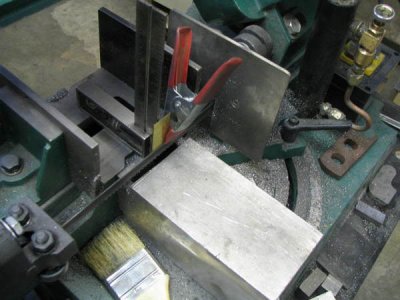Just reading this thread and I know its not current now, but will add my 2 cents for the future as it wasn't fully answered.
The original question of the saw not cutting square vertically is due to the fact that the blade cuts in the direction its pointing.
If it's pointing a little bit toward the vice then it will cut toward the vice and ping back straight once the offcut separates from the stock - leaving a gap as described originally. The taller the stock the further it pings back. If it's angled away from the vice the opposite happens.
On most saws using a 6" rule clamped to the blade (above the teeth so that its truely parallel to the back of the blade) and comparing to a engineers square (as shown in the picture in one of the replies above) will to the trick. Make sure the 6" rule is straight when looking along the flat of the rule (only one of the four I've got was good enough), then get up real close to see whether they're parallel. Adjust the angle of the guides with a 10" Crescent until they are parallel. You have to do this separately next to the bottom guide and again next to the top one.
However what has been missed so far is that if the arm doesn't fall square to the vice table, the blade, even if adjusted as above, it will still not cut square vertically. This happens for a small minority of saws that weren't manufactured right (like mine).
On mine the axle, that the saw arm pivots on, wasn't bored parallel to the vice table. Imagine that the axle is at say 20 degrees to the table, then think about the way arm will fall when looking along the flat surface of the vice bed, you'll see that it travels at an angle to the vice bed, and no matter what you adjust, it will NOT cut square at all thicknesses. In reality the angle is so small you don't see it, but the effect on the cut is still there. Mine was just over half a degree out so if I angled the blade a little in the opposite direction and could get it to cut square for a particular thickness of a particular material (say 2"x2" Aluminium) but then it wasn't square for 3x1 steel.
To know if you've got this problem, using 6" engineers square like in the photo above (but without the rule), place it so the blade of the set square just touches the tip of one of the teeth that is set toward the vice and clamp it up hard. Then carefully raise the arm until it clears the top of the square. It there's a gap or it pings off the blade of the square, you've got a saw like mine. If it pings off, reset the square so it just touches a tooth with the arm in the air, then lower it to find the amount of gap. Either way measure the gap with feeler gauges. Ideally there should be no gap. I'm guessing that at less than 10thou you could leave if you didn't want to do real accurate cuts. However mine was 55thou out and I had to fix it.
The only fix is to file or bore out the hole(s) in the ears of the base casting to move the axle parallel to the vice base. If you use a square with a 6" blade then the amount you measured above is the same as the amount you have to move one end of the pivot up or down, since the ears are also 6" apart.
No doubt you could mount it in a mill and bore the holes parallel and sleeve it to size, but I did it with a round file and a 5/8ID x 9/16OD brass sleeve bought from a local bearing house, positioned it with set screws so I could adjust it into position, then fixed the sleeve in place by injecting epoxy resin from a syringe through a hole in the bottom. Leave the sleeve a bit over length so you can use an o-ring each side to stop the resin from leaking out and cut flush once its hardened - jv


